
(Download a higher resolution picture by clicking on any
picture below. Photos on the right side of the page are from NASA
Dryden and the Air Force Flight Test Center History Office) 
NASA's first X-38
lifting-body vehicle  , referred to as Vehicle 131,
arrived at Dryden in 1997 for the flight-research portion of the
program. The X-38 is a technology demonstrator for the proposed
crew return vehicle, which is designed as an autonomous
"lifeboat" for the International Space Station. NASA
will use a crew return vehicle to evacuate crew members to Earth
in cases of injury or illness. Also, the six-person vehicle could
return the crew to Earth if an orbiter was unavailable or if the
Space Station became disabled. These photographs were taken on
July 28, 1997.
, referred to as Vehicle 131,
arrived at Dryden in 1997 for the flight-research portion of the
program. The X-38 is a technology demonstrator for the proposed
crew return vehicle, which is designed as an autonomous
"lifeboat" for the International Space Station. NASA
will use a crew return vehicle to evacuate crew members to Earth
in cases of injury or illness. Also, the six-person vehicle could
return the crew to Earth if an orbiter was unavailable or if the
Space Station became disabled. These photographs were taken on
July 28, 1997.
X-38 captive-carry flights  under the wing of Dryden's
venerable NB-52B began in late
1997. The first parachute drop test of V-131 was conducted on
March 12, 1998. The unanticipated behavior of the parafoil as it
deployed prompted a ten-month hiatus in the X-38 flight tests
while the parafoil was tested at Yuma Marine Corps Air Station.
The X-38 was dropped from the NB-52B for the second time on
February 6, 1999.
under the wing of Dryden's
venerable NB-52B began in late
1997. The first parachute drop test of V-131 was conducted on
March 12, 1998. The unanticipated behavior of the parafoil as it
deployed prompted a ten-month hiatus in the X-38 flight tests
while the parafoil was tested at Yuma Marine Corps Air Station.
The X-38 was dropped from the NB-52B for the second time on
February 6, 1999.
 The initial X-38 shape was derived
directly from the Martin
Marietta X-24A, seen here on static display with the NB-52B
at the 1970 Edwards AFB Open House. The aerodynamics of the X-24A
have already been thoroughly explored. Unlike the X-24A, which
landed at over two hundred miles per hour, the X-38 lands gently
under a large, wing-shaped parachute. Photographer: Richard
Lockett
The initial X-38 shape was derived
directly from the Martin
Marietta X-24A, seen here on static display with the NB-52B
at the 1970 Edwards AFB Open House. The aerodynamics of the X-24A
have already been thoroughly explored. Unlike the X-24A, which
landed at over two hundred miles per hour, the X-38 lands gently
under a large, wing-shaped parachute. Photographer: Richard
Lockett
 The first X-38 Space
Station Crew Return Vehicle was displayed hanging from the
pylon on the wing of the NB-52B at the 1997 Edwards AFB Open
House on October 18 and 19.
The first X-38 Space
Station Crew Return Vehicle was displayed hanging from the
pylon on the wing of the NB-52B at the 1997 Edwards AFB Open
House on October 18 and 19.
X-38 Crew Return Vehicle, V-131 aloft on a
captive carry mission on November 19, 1997. Photo ec97-44319-8
courtesy NASA Dryden. 
Link to a March 20, 1998 Dryden X-Press article about the first free flight of V-131 on March 12, 1998.
X-38, V-131 descends under its parafoil on its
first free flight on March 12, 1998. Photo EC98-44452-9 courtesy
NASA Dryden. 
Link to a March 20, 1998 Dryden X-Press article about the first free flight of V-131 on March 12, 1998.
 X-38 Crew Return
Vehicle V-131 sat on a trailer next to the NB-52B at the 1998
Edwards AFB Open House. This image can be viewed in 3-D. V-131 was
subsequently modified by Scaled Composites to more closely
represent the configuration of the orbital V-201.
X-38 Crew Return
Vehicle V-131 sat on a trailer next to the NB-52B at the 1998
Edwards AFB Open House. This image can be viewed in 3-D. V-131 was
subsequently modified by Scaled Composites to more closely
represent the configuration of the orbital V-201.
Link to a January 29, 1999 Dryden X-Press article about the upcoming second free flight of V-131.
The parafoil of the X-38 has deployed during its
second free flight on February 6, 1999. Photo EC99-44888-44
courtesy NASA Dryden. 
Link to a February 12, 1999 Dryden X-Press article about the second free flight of V-131 on February 6, 1999.
X-38, V-132 touches down at the end of its first
flight on March 5, 1999. Photo EC99-44923-157 courtesy NASA
Dryden. 
Link to a March 12, 1999 Dryden X-Press article about the first free flight of V-132 on March 5, 1999.
Link to a June 11, 1999 Dryden X-Press article about the upcoming second free flight of V-132.
NB-52B launches X-38, V-132 on July 9, 1999.
Photo EC99-45080-25 courtesy NASA Dryden.
X-38, V-132 after launch on July 9, 1999. Photo
EC99-45080-21 courtesy NASA Dryden.
X-38, V-132 landing on Rogers Dry Lake on July
9, 1999. Photo EC99-45080-101 Courtesy NASA Dryden.
 The second X-38
Space Station Lifeboat, V-132 is equipped with functional
flight control surfaces which allow it to perform extended glides
before deploying the recovery parafoil. It made its first flight
on March 5, 1999, its second flight on July 9, 1999, and its
third flight on March 30, 2000. It was displayed at the
International Aerospace Exhibition in Berlin from June 6 to June
12, 2000. It has been placed on static display at the Johnson
Space Center.
The second X-38
Space Station Lifeboat, V-132 is equipped with functional
flight control surfaces which allow it to perform extended glides
before deploying the recovery parafoil. It made its first flight
on March 5, 1999, its second flight on July 9, 1999, and its
third flight on March 30, 2000. It was displayed at the
International Aerospace Exhibition in Berlin from June 6 to June
12, 2000. It has been placed on static display at the Johnson
Space Center.
Link to a October 15, 1999 Dryden X-Press article about an upcoming captive carry flight of V-132.
Link to a November 26, 1999 Dryden X-Press article about the November 18, 1999 captive carry flight of V-132.
Link to a December 17, 1999 Dryden X-Press article about the development of the X-38.
Link to a February 22, 2000 Dryden X-Press article about a test of the parafoil for the X-38 at Yuma MarineCorps Air Station on January 19.
X-38, V-132 landing on Rogers Dry Lake at the
conclusion of the fifth free flight on March 30, 2000. Photo
EC00-0096-65 Courtesy NASA Dryden. 
Link to an April 14, 2000 Dryden X-Press article about the fifth flight of the X-38 on March 30, 2000.
Link to an August 25, 2000 Dryden X-Press article about the delivery of the X-38, V-131R on July 11, 2000.
Link to an August 25, 2000 Dryden X-Press article about the first captive flight of V-131R on August 4, 2000.
 Boeing NB-52B Stratofortress
Mothership, NASA 008 on static display at the 2000 Open House.
Boeing NB-52B Stratofortress
Mothership, NASA 008 on static display at the 2000 Open House.
The sixth flight of the X-38 was launched on Thursday, November 2, 2000. It was the first flight of the modified V-131R configuration. It demonstrated the full-size 7,500-square-foot parafoil to be used on the actual Space Station Lifeboat. Previous X-38 flights used a 5,000-square-foot parafoil.
 A short while before the
NB-52B took off with V-131R, the red Eagle Cam Cessna 337
Skymaster, N337WA with a Gyron 935 gyro-stabilized video system
took off from mid-field. It transmitted live television of the
parachute descent of the X-38. It is registered to Gyron Eagle,
Ltd of Pasadena, California. It is operated by Wolfe Air and is
regularly scheduled for MTV’s ‘Senseless Acts of
Video.
A short while before the
NB-52B took off with V-131R, the red Eagle Cam Cessna 337
Skymaster, N337WA with a Gyron 935 gyro-stabilized video system
took off from mid-field. It transmitted live television of the
parachute descent of the X-38. It is registered to Gyron Eagle,
Ltd of Pasadena, California. It is operated by Wolfe Air and is
regularly scheduled for MTV’s ‘Senseless Acts of
Video.
Link to Wolfe Air's fleet page.
Shortly before 8:00 A.M. the NB-52B lined up with the main runway.
 A white and blue NASA F/A-18B Hornet chase plane,
N846NA took off. It made one circuit of the pattern and lined up
with the runway to catch the NB-52B as it took off.
A white and blue NASA F/A-18B Hornet chase plane,
N846NA took off. It made one circuit of the pattern and lined up
with the runway to catch the NB-52B as it took off.
Visit the NASA Dryden F-18 chase aircraft Fact Page and F-18 chase aircraft Photo Gallery.
The tower radioed clearance for the NB-52B to take-off. The shrill whine of the eight J57 turbojets increased in volume and a dense cloud of black smoke billowed up behind the Stratofortress.
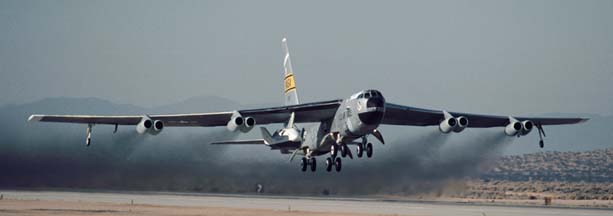 The NB-52B
lifted off after rolling nearly 8,000 feet.
The NB-52B
lifted off after rolling nearly 8,000 feet.
You can buy framed prints or greeting cards of this photograph.
Visit the NASA Dryden B-52 Stratofortress Mothership Fact Page.
 X-38, V-131R
is an 80%-scale testbed of the Space Station Crew Return Vehicle.
X-38, V-131R
is an 80%-scale testbed of the Space Station Crew Return Vehicle.
Forty years earlier,
the NB-52B takes off with the X-15-1 from runway 04 in September
1960. Photo courtesy AFFTC/HO. 
 Mission
symbols for the five previous X-38 parachute recovery system
tests can be seen on the side of the fuselage of the Boeing
NB-52B Stratofortress mothership.
Mission
symbols for the five previous X-38 parachute recovery system
tests can be seen on the side of the fuselage of the Boeing
NB-52B Stratofortress mothership.
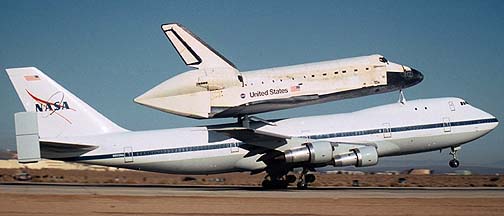 Shortly after
the NB-52B take-off, the 747 Shuttle Carrier Aircraft departed
with Shuttle OV-103, Discovery. Link to a page with more pictures
of the Discovery at Edwards Air Force
Base.
Shortly after
the NB-52B take-off, the 747 Shuttle Carrier Aircraft departed
with Shuttle OV-103, Discovery. Link to a page with more pictures
of the Discovery at Edwards Air Force
Base.
The NB-52B carries X-38, V-131R over the Mojave
Desert on November 2, 2000. Photo ec00-0317-154 courtesy NASA
Dryden. 
 High
overhead, contrails streamed from the engines of the NB-52B as it
flew around a racetrack pattern with its F/A-18B chase plane.
High
overhead, contrails streamed from the engines of the NB-52B as it
flew around a racetrack pattern with its F/A-18B chase plane.
The X-38 was dropped from the NB-52B at an altitude of 36,500 feet. It made an unplanned 360-degree roll after launch. After twenty-four seconds of gliding flight, it deployed an 80-foot diameter drogue chute. It deployed the 7,000 square foot parafoil at an altitude of 19,000 feet.
 A smoke generator has
been installed on the left wing of the Boeing NB-52B
Stratofortress mothership to assist in tracking the airplane.
A smoke generator has
been installed on the left wing of the Boeing NB-52B
Stratofortress mothership to assist in tracking the airplane.
 A Bell UH-1 Huey helicopter flew near the X-38 to
transmit live television of the test. The parafoil turned slowly
in a half circle as it descended to the lakebed.
A Bell UH-1 Huey helicopter flew near the X-38 to
transmit live television of the test. The parafoil turned slowly
in a half circle as it descended to the lakebed.
X-38, V-131R descends toward Rogers Dry Lake on
November 2, 2000. Photo EC00-0317-41 courtesy NASA Dryden. 
 The trailing edge of the
parachute curled downward to flare the chute for landing.
The trailing edge of the
parachute curled downward to flare the chute for landing.
 The skids of the X-38 hit the lakebed and kicked up a
cloud of brown dust as the lifting body pitched forward for a
moment.
The skids of the X-38 hit the lakebed and kicked up a
cloud of brown dust as the lifting body pitched forward for a
moment.
 The parafoil settled to the ground alongside the X-38,
reflected in the lakebed mirage.
The parafoil settled to the ground alongside the X-38,
reflected in the lakebed mirage.
X-38, V-131R on Rogers Dry Lake following the
sixth free flight on November 2, 2000. Photo EC00-0317-41
courtesy NASA Dryden. 
The NB-52B
landing after launching the X-38 on November 2, 2000.
Photo ec00-0318-1 courtesy NASA Dryden.
Link to the NASA Dryden press release about the X-38 parachute test on November 2.
 Boeing NB-52B Stratofortress,
52-0008 with X-38 V-131R on the flightline.
Boeing NB-52B Stratofortress,
52-0008 with X-38 V-131R on the flightline.
 The ground crew works to prepare
the X-38 V-131R for the seventh test drop of the program.
The ground crew works to prepare
the X-38 V-131R for the seventh test drop of the program.
 There had been a problem with some
of the radio gear, so it was being switched out.
There had been a problem with some
of the radio gear, so it was being switched out.
 Gordon Fullerton was
walking around the NB-52B doing the pilot's pre-flight
check. Fullerton was one of the first Space Shuttle test
pilots. Now he flies NASA's 747 shuttle carrier and the NB-52B.
He stood out from the ground crew in his tan coveralls..
Gordon Fullerton was
walking around the NB-52B doing the pilot's pre-flight
check. Fullerton was one of the first Space Shuttle test
pilots. Now he flies NASA's 747 shuttle carrier and the NB-52B.
He stood out from the ground crew in his tan coveralls..
 The man in the tan coveralls is
Gordon Fullerton, the pilot of the NB-52B.
The man in the tan coveralls is
Gordon Fullerton, the pilot of the NB-52B.
 The ground crew wraps up the launch
preparations for the X-38 V-131R.
The ground crew wraps up the launch
preparations for the X-38 V-131R.
 Some of the mission
symbols on the side of the fuselage of the NB-52B have been
revised. The stylized flying horse symbols for the Pegasus
satellite launches have been replaced with sihouettes of the
actual rocket booster.
Some of the mission
symbols on the side of the fuselage of the NB-52B have been
revised. The stylized flying horse symbols for the Pegasus
satellite launches have been replaced with sihouettes of the
actual rocket booster.
 X-38 V-131R is fully prepared for
launch.
X-38 V-131R is fully prepared for
launch.
 The ground crew fires up the ground
power unit to start the engines of the NB-52B.
The ground crew fires up the ground
power unit to start the engines of the NB-52B.
 Gordon Fullerton prepares to taxi
the NB-52B to runway 22.
Gordon Fullerton prepares to taxi
the NB-52B to runway 22.
 NASA Boeing-McDonnell-Douglas
F/A-18B Hornet chase planes, N852NA and N846NA take off from
runway 22 at Edwards AFB.
NASA Boeing-McDonnell-Douglas
F/A-18B Hornet chase planes, N852NA and N846NA take off from
runway 22 at Edwards AFB.
 The Hornet chase planes circled and
lined up with the runway to catch the NB-52B as it took
off. Both Hornets were on our side of the runway.
The Hornet chase planes circled and
lined up with the runway to catch the NB-52B as it took
off. Both Hornets were on our side of the runway.
 At 9:20, the
Stratofortress belched a cloud of unburned hydrocarbons from its
eight J57 turbojet engines and started rolling toward us.
At 9:20, the
Stratofortress belched a cloud of unburned hydrocarbons from its
eight J57 turbojet engines and started rolling toward us.
 The nose gear of the NB-52B has
just lifted off the ground.
The nose gear of the NB-52B has
just lifted off the ground.
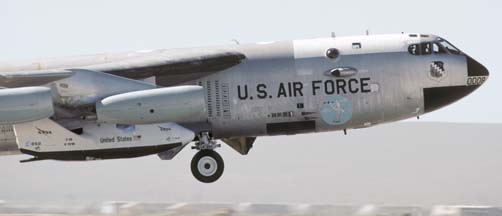 The NB-52B lifted off the ground
just as it came past us. At the same time, one Hornet
passed directly over us and the other passed just behind us, just
a few hundred feet off the ground.
The NB-52B lifted off the ground
just as it came past us. At the same time, one Hornet
passed directly over us and the other passed just behind us, just
a few hundred feet off the ground.
 Boeing NB-52B Stratofortress,
52-0008 takes off with X-38 V-131R.
Boeing NB-52B Stratofortress,
52-0008 takes off with X-38 V-131R.
 Boeing NB-52B Stratofortress,
52-0008 departs to the west with X-38 V-131R.
Boeing NB-52B Stratofortress,
52-0008 departs to the west with X-38 V-131R.
 The trio of planes
turn to the north and climb to the launch altitude of 37,500
feet. There would be about an hour before the launch of the
X-38. We returned to NASA Dryden to watch the proceedings on
closed circuit TV.
The trio of planes
turn to the north and climb to the launch altitude of 37,500
feet. There would be about an hour before the launch of the
X-38. We returned to NASA Dryden to watch the proceedings on
closed circuit TV.
 About five minutes
before the drop they turned on a smoke generator on the left
inboard engine nacelle of the NB-52B. I stepped outside and could
see the smoke trail approaching from the east. The
temperature outside was getting a bit hot.
About five minutes
before the drop they turned on a smoke generator on the left
inboard engine nacelle of the NB-52B. I stepped outside and could
see the smoke trail approaching from the east. The
temperature outside was getting a bit hot.
I tracked the NB-52B and its Hornet chase planes as it crossed over the Air Force Base. I watched carefully to see the X-38 fall away from the Stratofortress and deploy its parafoil. The parafoil is larger in area than the wing of a 747.
The smoke trail curved to the right and then stopped. I searched the sky for the X-38 and its huge parafoil, but I couldn't find it.
I went back inside and was informed that "they called an abort at about T-minus nothing." They had suffered a failure of the FTS. It would take a half hour to cool down before they could attempt the launch again. I went outside again to watch for the return of the Stratofortress.
 The NB-52B flies over Edwards AFB
with X-38 V-131R following the launch abort. The small white
object at the right is a weather balloon that was released about
an hour earlier.
The NB-52B flies over Edwards AFB
with X-38 V-131R following the launch abort. The small white
object at the right is a weather balloon that was released about
an hour earlier.
A short while later I learned that they had called an abort for the day. The launch systems were going to take so long to reset that the Hornets wouldn't have enough fuel to follow the X-38 after launch.
Link to the NASA Dryden press release about the X-38 launch abort on June 29.
Visit the NASA Dryden X-38 Project page.
Link to the NASA Dryden X-38 Photo Gallery.
Link to the NASA Dryden X-38 Fact Sheet.
Link to the NASA Human Spaceflight X-38 Crew Return Vehicle page.
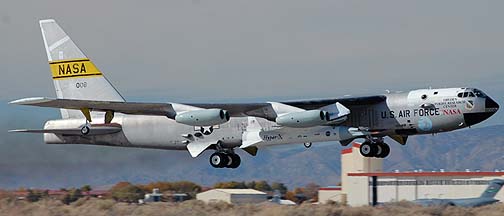 Boeing NB-52B
Stratofortress Mothership.
Boeing NB-52B
Stratofortress Mothership.
eBook edition of Balls Eight: History of the Boeing NB-52B Stratofortress Mothership |
||
|
My book Balls Eight: History of the Boeing NB-52B Stratofortress Mothership is now available as an eBook for just $10.99, a considerably reduced price compared to the print edition. It has been asserted that the Boeing NB-52B Stratofortress, carrying Air Force serial 52-0008, can lay claim to being the airplane that has seen and participated in more history than any other single airplane. For forty-five years, the NB-52B was a fixture at Edwards Air Force Base. While the NB-52B is most famous for launching the three North American X-15 rocket planes, it continued to serve in the role of launch platform for a multitude of programs until its final mission, launching the Mach-10 X-43A Hyper-X, on November 16, 2004. It was the oldest flying B-52 by nearly ten years. The eBook edition is profusely illustrated with vintage photographs and diagrams and has more pictures than the print edition. It can be dowloaded directly from Lulu.com. It will soon be available from Apple iBookstore, Amazon, Barnes & Noble, and Kobo. | ||
|
Balls Eight: History of the Boeing NB-52B Stratofortress Mothership |
||
It has been asserted that the Boeing NB-52B Stratofortress, carrying Air Force serial 52-0008, can lay claim to being the airplane that has seen and participated in more history than any other single airplane. For forty-five years, the NB-52B was a fixture at Edwards Air Force Base. While the NB-52B is most famous for launching the three North American X-15 rocket planes, it continued to serve in the role of launch platform for a multitude of programs until its final mission on November 16, 2004. It was the oldest flying B-52 by nearly ten years.The NB-52B launched the three X-15 hypersonic rocket planes.
It launched the Northrop HL-10, Northrop M2-F2/F3, Martin Marietta X-24A and Martin Marietta X-24B lifting bodies.
It simulated the steep, power off approach to landing used by the Space Shuttles.
It assisted in the collection of data about wake turbulence from large aircraft.
It served as an air-to-air gunnery target.
It launched 3/8-scale F-15 Remotely Piloted Research Vehicles (RPRV) and Spin Research Vehicles (SRV).
It launched a Ryan Firebee II drone and the Ryan Firebee based Drones for Aeroelastic Structures Testing (DAST).
It launched the Highly Maneuverable Aircraft Technology (HiMAT) RPRVs.
It dropped the 48,000-pound Space Shuttle Reusable Booster Drop Test Vehicle (SRB/DTV).
It released a simulated F-111 crew module from its bomb bay to evaluate new parachute recovery systems.
It was the first airplane to launch a satellite into orbit on the Orbital Sciences Pegasus booster.
It tested the drag chute used to decelerate space shuttle orbiters.
It tested pollution reducing fuel additives with a pair of jet engines mounted under its bomb bay.
It launched the X-38 Space Station Crew Return Vehicles.
It launched the X-43A Hyper-X Supersonic Combustion Ramjets.
The book is 200 pages long. It contains 246 color photographs, 89 black and white photographs, and 2 other illustrations.
You can preview the first several pages of the book.
Books are printed on demand by Lulu.com. When you order one, it is placed in your Lulu.com shopping cart. Lulu.com prints, packages, and ships the book direct to you.

Put a copy of the softcover edition of Balls Eight: History of the Boeing NB-52B Stratofortress Mothership in your Lulu.com shopping cart for $74.95.

Put a copy of the hardcover edition of Balls Eight: History of the Boeing NB-52B Stratofortress Mothership in your Lulu.com shopping cart for $79.95.
Revell has re-released Monogram's 1/72-scale Boeing NB-52B Stratofortress with X-15A-2 kit. You need this book to help you establish the appropriate paint scheme for any particular NB-52B mission that you want to model.
The book is 96 pages long.
You can preview the first several pages of the book.
Books are printed on demand by Lulu.com. When you order one, it is placed in your Lulu.com shopping cart. Lulu.com prints, packages, and ships the book direct to you.
 Put a copy of the softcover edition of Painting Guide for the Boeing Stratofortress Motherships in your Lulu.com shopping cart for $44.95.
Put a copy of the softcover edition of Painting Guide for the Boeing Stratofortress Motherships in your Lulu.com shopping cart for $44.95.
You can buy a 2020 calendar featuring photographs of the Boeing NB-52B Stratofortress Mothership that launched the X-15s in the 1960s and continued launching research vehicles until 2004.
It has been asserted that the Boeing NB-52B Stratofortress, carrying Air Force serial 52-0008, can lay claim to being the airplane that has seen and participated in more history than any other single airplane. This calendar features a dozen pictures of the NB-52B carrying some of the research vehicles that it launched over the years. Photo sources: Air Force, NASA, Richard Lockett, Brian Lockett:
North American X-15-1, 1960
North American X-15-3, 1963
North American X-15A-2, 1967
Northrop HL-10, 1969
Martin-Mariettta X-24A, 1970
Northrop M2-F3, 1972
Martin-Mariettta X-24B, 1973
Orbital Sciences Pegasus, 1989
Supersonic Supercruise, 1995
X-38 V-131R, 2000
X-43A Hyper-X, 2004
 Put a copy of the Balls Eight: Boeing NB-52B Stratofortress Mothership: 2020 calendar in your Lulu.com shopping cart for $14.95.
Put a copy of the Balls Eight: Boeing NB-52B Stratofortress Mothership: 2020 calendar in your Lulu.com shopping cart for $14.95.
The card set includes a photo of the NB-52B, 52-0008 taking off with X-38 Crew Return Vehicle, V-131R.
 Books about
Lifting Bodies, Edwards Air Force Base, and the X-38 available
from
Books about
Lifting Bodies, Edwards Air Force Base, and the X-38 available
from 
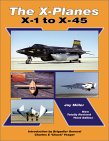 The X-Planes: X-1 to X-45: 3rd Edition
by Jay Miller
The X-Planes: X-1 to X-45: 3rd Edition
by Jay Miller
 Flying Without Wings : Nasa Lifting
Bodies and the Birth of the Space Shuttle by Milton O. Thompson
Flying Without Wings : Nasa Lifting
Bodies and the Birth of the Space Shuttle by Milton O. Thompson
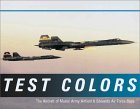 Test Colors: The Aircraft of Muroc Army Airfield
and Edwards Air Force Base by Rene Francillon
Test Colors: The Aircraft of Muroc Army Airfield
and Edwards Air Force Base by Rene Francillon
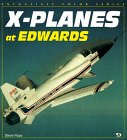 X-Planes at Edwards (Enthusiast Color
Series) by
Steve Pace
X-Planes at Edwards (Enthusiast Color
Series) by
Steve Pace
 Edwards Air Force Base : Open House at the USAF
Flight Test Center 1957-1966 : A Photo Chronicle of
Aircraft Displayed (Schiffer Military History) by Robert D. Archer
Edwards Air Force Base : Open House at the USAF
Flight Test Center 1957-1966 : A Photo Chronicle of
Aircraft Displayed (Schiffer Military History) by Robert D. Archer
 Angle of Attack : Harrison Storms and the Race to
the Moon by Mike Gray. The biography of Harrison Storms, who
was instrumental in the development and operation of the X-15.
Angle of Attack : Harrison Storms and the Race to
the Moon by Mike Gray. The biography of Harrison Storms, who
was instrumental in the development and operation of the X-15.
 At the Edge of Space : The X-15 Flight Program
by Milton O. Thompson. The story of test flying the X-15 from the
point of view of the pilot.
At the Edge of Space : The X-15 Flight Program
by Milton O. Thompson. The story of test flying the X-15 from the
point of view of the pilot.
Send a message to Brian.
Go to home page of the Goleta Air and Space Museum.